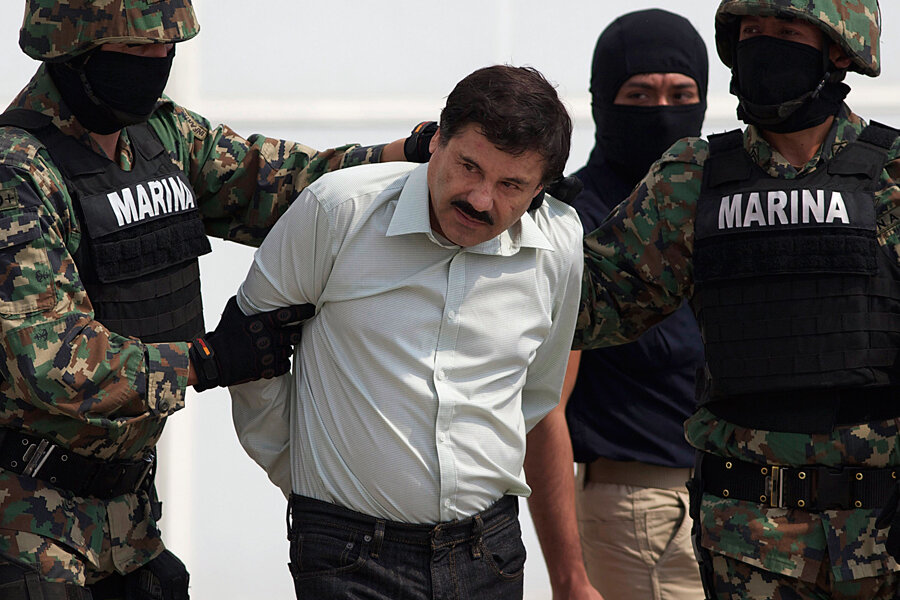Little hope that 'El Chapo' capture will disrupt drug supply flooding the US
Loading...
| Chicago
The capture this weekend in Mexico of the notorious Joaquin Guzman, presumed to head one of the world's most powerful and violent drug cartels, is not likely to stanch the flow of illicit drugs into the United States, experts say. The reason: The huge operation does not require the oversight of just one man to keep it going, and the cartel is deep in experienced hands who understand the nature of the business.
To make a dent in the well-oiled drug operation, "you'd have to round up several more people, because the federation is huge," says Sylvia Longmire, a former special agent with the US Air Force and the author of “Cartel: The Coming Invasion of Mexico’s Drug Wars.” "The pipeline will, for now, most likely remain intact."
That's disappointing news to anyone who may have hoped that the capture of Mr. Guzman, a.k.a. "El Chapo" (Shorty), would disrupt the supply line of drugs – marijuana, methamphetamine, and cocaine – entering the US from south of the border. In the years since El Chapo escaped from a Mexican prison in 2001, his Sinaloa cartel has squashed most competitors and has come to dominate the drug-trafficking industry. It's now responsible, for instance, for 80 percent of the US meth trade, according to a 2013 study published by Seguridad con Democracia, a think tank in Mexico that focuses on security issues.
Central to the Sinaloa’s US traffic-distribution network is Chicago. The city, centrally located, has become a hub for distributing drugs to other cities across the country, and its sizable Mexican population (both legal and illegal) provides the cartel with ready access to foot soldiers. For those reasons, the US Attorney's Office in Chicago indicted Guzman in absentia in August 2009 for conspiring to transport drugs across international borders, and the US has prosecuted key figures in the cartel's US operations here. The Chicago Crime Commission named Guzman public enemy No. 1, a designation previously given to a crime boss from another era, Al Capone.
“The Sinaloa presents its Chicago operatives with the drug of the day, and then those operatives have the organization that accomplishes the distribution to several dozen states,” says George Grayson, an emeritus professor of government at William and Mary College in Williamsburg, Va., and the author of “The Cartels: The Story of Mexico’s Most Dangerous Organizations and their Impact on US Security.”
Sinaloa’s presence has created havoc on Chicago’s streets, local authorities say. Eighty percent of the drugs that show up in Chicago each year – with a street value of $3 billion – originate with the Sinaloa cartel, police say. Police officials put much of the blame for the violence that has plagued the city in recent years on local gangs fighting over distribution rights for the Sinaloa cartel's products, or on competition for drug-related jobs. According to the US Drug Enforcement Administration (DEA), the cartel is a major Chicago employer, responsible for hiring as many as 150,000 workers to help bring in, store, and distribute illegal drugs.
“The arrest of Chapo Guzman is significant,” Chicago Police Superintendent Garry McCarthy said, in a statement released this weekend. "This is a victory, but we know the tentacles of his cartel still exist and much more work remains to be done. Demand for narcotics will still remain, so we will continue to partner with the DEA as they fight international drug trade, and we will remain focused on our efforts to eliminate the factors that drive violence in our city.”
Guzman was largely responsibly for cartel's overarching strategy, establishing relationships with crime organizations in Europe, Australia, and elsewhere, according to Ms. Longmire. “El Chapo was the CEO, and even though the CEO is gone the board of directors are running the show,” she says.
Others agree that there is stability at the top of the cartel – and that there are few who would challenge it. Two of Guzman’s top lieutenants remain free, and they are just as adept and feared as their boss, says Professor Grayson.
One is purported to be Ismael “Mayo” Zambada, alleged to have worked alongside Guzman for decades. “They virtually complete each other’s sentences,” says Grayson. The other is Juan José Esparragoza Moreno, a former police detective and a “savvy negotiator” between rival cartels, Grayson says.
Both men are alleged to have run the cartel while Guzman was in prison for six years – and to have orchestrated his escape. Analysts say Guzman is unlikely to provide authorities with information that could lead to their capture.
“The Sinaola cartel has no real competitor” in the form of rival cartels that could challenge for control of parts of the drug trade, Grayson says.
US agencies are believed to have provided information – including a wiretap by Immigration and Customs Enforcement officials in Arizona – that led to Guzman’s capture, after a 13-year manhunt. Some analysts hope that will signal increased cooperation between the US and Mexican governments in combatting drug trafficking. Under former President Felipe Calderón, Mexico was more active in soliciting help from the US in pursuing the cartels. Current President Enrique Peña Nieto has made it less of a priority, focusing on the economy and on reducing violent crime rather than targeting sweeps of specific cartels.
Under Mr. Calderón, security agencies in the US, such as the DEA, were free to hold informal meetings with their Mexican counterparts. That stopped under Mr. Peña Nieto, who required that any cross-border interaction had to be approved by his administration.
“That hobbled cooperation and perhaps the success of bringing down El Chapo sooner,” Grayson says.








